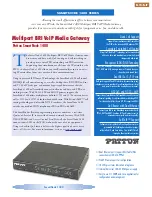
Version 6.6
707
Mediant 3000
User's Manual
53. Configuration Parameters Reference
Parameter
Description
device handles the call as described in option
[3].)
The device interworks ISDN Setup with an Off Hook Indicator of
“Voice” to SIP INVITE Request-URI and Contact header with
“tgrp=hotline;trunk-context=dsn.mil”.
The device interworks ISDN Setup with an Off Hook indicator of
“Data” to SIP INVITE Request-URI and Contact header with
“tgrp=hotline-ccdata;trunk-context=dsn.mil”.
If ISDN Setup does not contain an Off Hook Indicator IE and the
Bearer Capability IE contains “Unrestricted 64k”, the outgoing
INVITE Request-URI and Contact header includes
“tgrp=ccdata;trunk-context=dsn.mil”. If the Bearer Capability IE
contains “Speech”, the INVITE in this case does not contain tgrp
and trunk-context parameters.
Note:
IP-to-Tel configuration (using the PSTNPrefix parameter)
overrides the 'tgrp' parameter in incoming INVITE messages.
Web/EMS: TGRP Routing
Precedence
[TGRProutingPrecedenc
e]
Determines the precedence method for routing IP-to-Tel calls -
according to the Inbound IP Routing Table or according to the SIP 'tgrp'
parameter.
[0]
= (Default) IP-to-Tel routing is determined by the Inbound IP
Routing Table (PSTNPrefix parameter). If a matching rule is not
found in this table, the device uses the Trunk Group parameters for
routing the call.
[1]
= The device first places precedence on the 'tgrp' parameter for
IP-to-Tel routing. If the received INVITE Request-URI does not
contain the 'tgrp' parameter or if the Trunk Group number is not
defined, then the Inbound IP Routing Table is used for routing the
call.
Below is an example of an INVITE Request-URI with the 'tgrp'
parameter, indicating that the IP call should be routed to Trunk Group 7:
INVITE sip:200;tgrp=7;trunk-
[email protected];user=phone SIP/2.0
Notes:
For enabling routing based on the 'tgrp' parameter, the UseSIPTgrp
parameter must be set to 2.
For IP-to-Tel routing based on the 'dtg' parameter (instead of the
'tgrp' parameter), use the parameter UseBroadsoftDTG.
[UseBroadsoftDTG]
Determines whether the device uses the 'dtg' parameter for routing IP-
to-Tel calls to a specific Trunk Group.
[0]
Disable (default)
[1]
Enable
When this parameter is enabled, if the Request-URI in the received SIP
INVITE includes the 'dtg' parameter, the device routes the call to the
Trunk Group according to its value. This parameter is used instead of
the 'tgrp/trunk-context' parameters. The 'dtg' parameter appears in the
INVITE Request-URI (and in the To header).
For example, the received SIP message below routes the call to Trunk
Group ID 56:
INVITE sip:[email protected];dtg=56;user=phone SIP/2.0
Note:
If the Trunk Group is not found based on the 'dtg' parameter, the
Inbound IP Routing Table is used instead for routing the call to the
appropriate Trunk Group.
Summary of Contents for Mediant 3000
Page 2: ......
Page 26: ...User s Manual 26 Document LTRT 89729 Mediant 3000 Reader s Note...
Page 27: ...Part I Getting Started with Initial Connectivity...
Page 28: ......
Page 40: ...User s Manual 40 Document LTRT 89729 Mediant 3000 Reader s Notes...
Page 41: ...Part II Management Tools...
Page 42: ......
Page 44: ...User s Manual 44 Document LTRT 89729 Mediant 3000 Reader s Notes...
Page 80: ...User s Manual 80 Document LTRT 89729 Mediant 3000 Reader s Notes...
Page 98: ...User s Manual 98 Document LTRT 89729 Mediant 3000 Reader s Notes...
Page 103: ...Part III General System Settings...
Page 104: ......
Page 113: ...Part IV General VoIP Configuration...
Page 114: ......
Page 144: ...User s Manual 144 Document LTRT 89729 Mediant 3000 Reader s Notes...
Page 164: ...User s Manual 164 Document LTRT 89729 Mediant 3000 Reader s Notes...
Page 222: ...User s Manual 222 Document LTRT 89729 Mediant 3000 Reader s Notes...
Page 224: ...User s Manual 224 Document LTRT 89729 Mediant 3000 Reader s Notes...
Page 275: ...Part V Gateway and IP to IP Application...
Page 276: ......
Page 278: ...User s Manual 278 Document LTRT 89729 Mediant 3000 Reader s Notes...
Page 399: ...Part VI Session Border Controller Application...
Page 400: ......
Page 402: ...User s Manual 402 Document LTRT 89729 Mediant 3000 Reader s Notes...
Page 464: ...User s Manual 464 Document LTRT 89729 Mediant 3000 Reader s Notes...
Page 465: ...Part VII Stand Alone Survivability Application...
Page 466: ......
Page 474: ...User s Manual 474 Document LTRT 89729 Mediant 3000 Reader s Notes...
Page 494: ...User s Manual 494 Document LTRT 89729 Mediant 3000 Reader s Notes...
Page 497: ...Part VIII IP Media Capabilities...
Page 498: ......
Page 501: ...Part IX High Availability System...
Page 502: ......
Page 515: ...Part X Maintenance...
Page 516: ......
Page 522: ...User s Manual 522 Document LTRT 89729 Mediant 3000 Reader s Notes...
Page 524: ...User s Manual 524 Document LTRT 89729 Mediant 3000 Reader s Notes...
Page 552: ...User s Manual 552 Document LTRT 89729 Mediant 3000 Reader s Notes...
Page 562: ...User s Manual 562 Document LTRT 89729 Mediant 3000 Reader s Notes...
Page 565: ...Part XI Status Performance Monitoring and Reporting...
Page 566: ......
Page 578: ...User s Manual 578 Document LTRT 89729 Mediant 3000 Reader s Notes...
Page 609: ...Part XII Diagnostics...
Page 610: ......
Page 624: ...User s Manual 624 Document LTRT 89729 Mediant 3000 Reader s Notes...
Page 626: ...User s Manual 626 Document LTRT 89729 Mediant 3000 Reader s Notes...
Page 638: ...User s Manual 638 Document LTRT 89729 Mediant 3000 Reader s Notes...
Page 639: ...Part XIII Appendix...
Page 640: ......
Page 864: ...User s Manual 864 Document LTRT 89729 Mediant 3000 Reader s Notes...
Page 871: ...Version 6 6 871 Mediant 3000 User s Manual 55 Selected Technical Specifications Reader s Notes...
















































